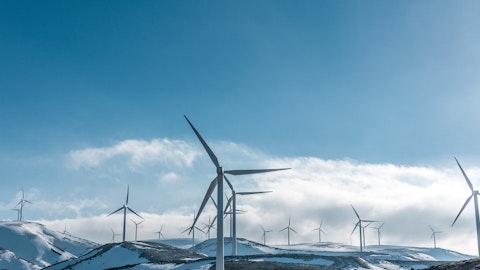Operator: And we’ll take our next question from Mike Halloran with Baird. Your line is open.
Mike Halloran : Hey. Good morning, everyone.
Patrick Decker : Hey, good morning.
Sandy Rowland : Hey Mike.
Mike Halloran : So like Deane, thanks Patrick for everything over the years. It’s been a long, long run, but we really appreciate everything. Sandy, same. Not quite as long, but best of luck moving forward. And obviously Bill and Matthew, I look forward to working with both of you. So I appreciate it, everyone.
Patrick Decker : Thanks Mike.
Mike Halloran : I don’t think I’ve had four congratulations on a call before.
Patrick Decker : Yeah. Hey Mike, we don’t do things orthodox here, so – but we do them the right way through, it’s called succession planning. So thank you.
Mike Halloran : No problem. All right. So following up on Deane’s M&CS order question, maybe broaden it out a little bit. If you think about end markets heading into 2024, I certainly appreciate Matthew’s comments on the fourth quarter itself. Where are the optimistic points? Where are the concern points? A lot of moving pieces here, right? You have really strong backlog. You have some regulatory tailwinds that are starting to hit or at least it seems like it. But you also have this uncertain macro backdrop in some of these emerging market regions where there’s a little less clarity. So maybe just talk about some of those moving pieces as you’re thinking about next year and where you think there could be some demand sustainability or where you have a little bit more concern points.
Matthew Pine: No, it’s a great question Mike. We’re committed to both the legacy businesses, long-range plans that were presented back in ‘21. Just start right there and just get that out. And really we have great momentum heading into next year with the platform that’s been built by the Evoqua, Xylem combination. If you look back over the past decade of Patrick’s leadership, 50% of the company didn’t exist six or seven short years ago, and we’re really operating from a position of strength in terms of the platform that has been built. So that feels really good as a jump-off point. I think if you kind of think about the macro drivers or favorable drivers, the secular trends continue to be strong, scarcity of water, aged infrastructure in developed markets, water quality is increasingly an issue, and as many of us have seen this year with flooding happening all over the world.
So those trends will continue and they’ll continue to buoy the business. Government funding, we talk a lot about the funding. It’s going to be a dimmer switch. It’s going to come over a period of time. But the next six to seven years, we’ll see continued trickle funding globally, not only in the US. I think the resiliency of our OpEx and utilities will continue to be a strong point. I think the ISS durable business model, with the combination coming together with 75% services and aftermarket, gives us a lot more diversity of cash flows as we move into ‘24. And then lastly, M&CS backlog, which we just talked about with the supply chain improvements, I think are all positives. I think if I had to mention a few watch items, our more cyclical pieces of the portfolio with the end markets and applied water are definitely a watch item.
There’s pockets of industrial weakness. It’s really niche when you think about Ag or marine, but they are very small pieces of our business. But in general, industrial has tended to hold up pretty well. And then I think the last thing I’d mentioned is China, which I mentioned in the opening comments. Industrial has remained pretty resilient in China for us. It’s been the utilities, but it’s been more on just a push to the right more than anything in China, which we can talk a little bit more about that later, but that’s kind of the insights that we give. Obviously in our February earnings call, we’ll be able to give more color, but that’s what I see right now.
Mike Halloran : Great. I appreciate that. And then second question, just on the pricing and mix. So price costs in the quarter sounds like the backlog for M&CS is better than the margin profile today, which makes a lot of sense. Maybe just talk about some of those two dynamics as you’re looking forward ability to continue to manage the price side of things against resilient inflation and how we should think about mix on a forward basis.
Matthew Pine: Yeah, this price cost in Q3, continue to be positive for Xylem. We’re up 70 bips. We expect pricing to moderate in 2024 as we lap previous increases. I think ‘24 is going to fall more in line with historical trends, but in terms of M&CS, definitely price costs contributed to a little bit of the incrementals this quarter. But we feel really positive in a step up in Q4 and into ‘24, we’ve taken some pricing actions that will start to really materialize into ‘24. And in terms of the mix, it’ll continue to be a little bit lumpy with energy, but we’re working that backlog down and we expect that to normalize as we get into ‘24.
Mike Halloran : Great. I appreciate it. Thanks everyone.
Matthew Pine: Thank you.
Operator: And we’ll take our next question from Scott Davis with Melius Research.
Scott Davis: Hey, good morning, everyone.
Matthew Pine: Good morning.
Sandy Rowland: Good morning, Scott.
Patrick Decker: Good morning, Scott.
Scott Davis: I’ll let Dean’s congratulations kind of take the lead for me. And since he’s the elder statesman, I will defer to him, but I agree with everything you said to everybody.
Patrick Decker: Thank you, Scott. Thank you.
Scott Davis: No problem. Matthew, can you, just on China, can you guys help us understand kind of the interplay between OpEx and CapEx? I mean, when I assume it’s all CapEx that’s declined and pushed to the right, but is there a certain OpEx impact as well?
Matthew Pine: Yeah, I think it’s – yeah, in terms of China, yeah. The under – I’ll just say, the underlying demand does remain fairly healthy. It’s like I said, industrial has been more resilient than utilities, but with regard to utilities, it’s a little bit of a mixed bag. It’s really timing of funding, not only for CapEx, but also for OpEx as well. And as we’ve seen in the treatment piece of our business, in China it’s been actually a little bit more resilient than transport. Transport tends to be a bit more OpEx centric. So it’s a little bit of a mixed bag, Scott, when it comes to the funding. It’s both CapEx and OpEx.
Patrick Decker: Hey Scott, I guess two weeks ago I was – two weeks ago I was there for a week and I spent time with our leadership gang and the team and visited our locations in Nanjing, Shenyang, Shanghai, traveled around, met with customers, met with the team, and the whole purpose was to really get a sense for kind of how things feel in China. And all I can say is based upon our portfolio, what we have there. Yeah, there’s some near term shifting to the right on when backlog gets converted on the utility side, but underlying demand is still very strong there. That market is very positive and as many of you’ve heard me say before, as my father said, every generation thinks theirs is the last. This is my third time talking about the future of China in terms of demand for water and environment, and things felt very, very good in terms of robust underlying demand.



